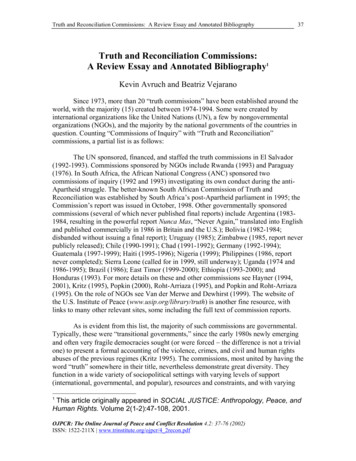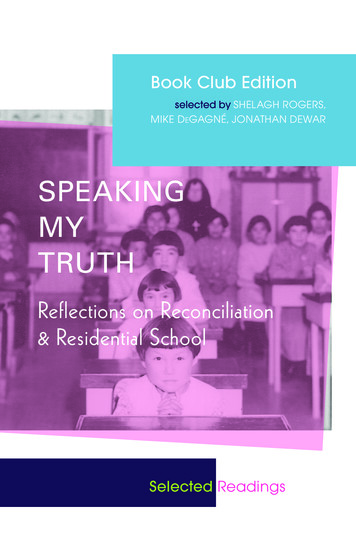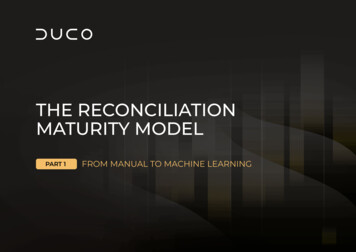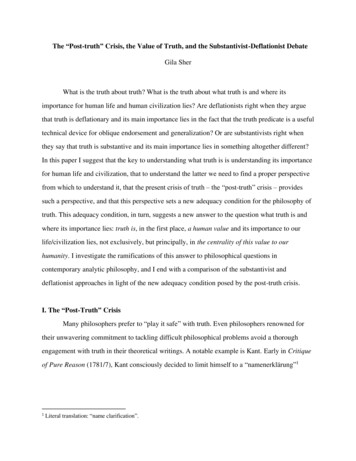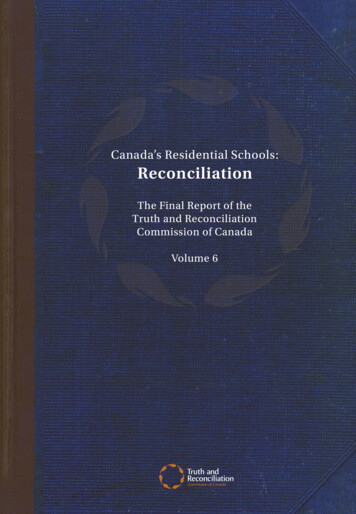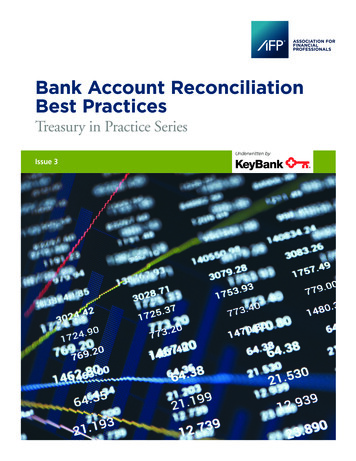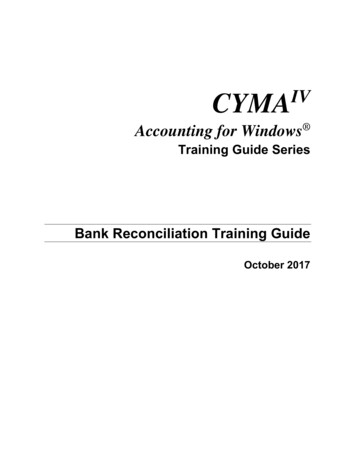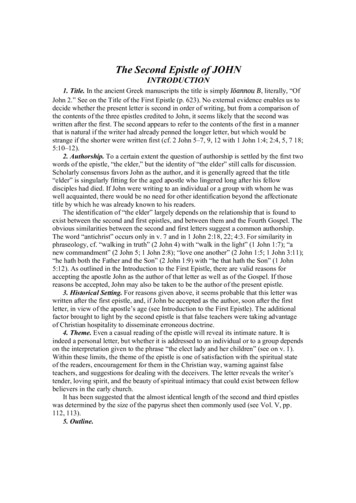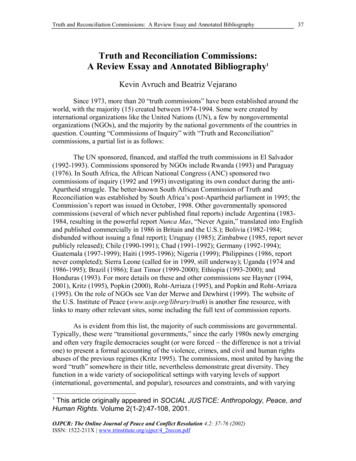
Transcription
Truth and Reconciliation Commissions: A Review Essay and Annotated Bibliography37Truth and Reconciliation Commissions:A Review Essay and Annotated Bibliography1Kevin Avruch and Beatriz VejaranoSince 1973, more than 20 “truth commissions” have been established around theworld, with the majority (15) created between 1974-1994. Some were created byinternational organizations like the United Nations (UN), a few by nongovernmentalorganizations (NGOs), and the majority by the national governments of the countries inquestion. Counting “Commissions of Inquiry” with “Truth and Reconciliation”commissions, a partial list is as follows:The UN sponsored, financed, and staffed the truth commissions in El Salvador(1992-1993). Commissions sponsored by NGOs include Rwanda (1993) and Paraguay(1976). In South Africa, the African National Congress (ANC) sponsored twocommissions of inquiry (1992 and 1993) investigating its own conduct during the antiApartheid struggle. The better-known South African Commission of Truth andReconciliation was established by South Africa’s post-Apartheid parliament in 1995; theCommission’s report was issued in October, 1998. Other governmentally sponsoredcommissions (several of which never published final reports) include Argentina (19831984, resulting in the powerful report Nunca Mas, “Never Again,” translated into Englishand published commercially in 1986 in Britain and the U.S.); Bolivia (1982-1984;disbanded without issuing a final report); Uruguay (1985); Zimbabwe (1985, report neverpublicly released); Chile (1990-1991); Chad (1991-1992); Germany (1992-1994);Guatemala (1997-1999); Haiti (1995-1996); Nigeria (1999); Philippines (1986, reportnever completed); Sierra Leone (called for in 1999, still underway); Uganda (1974 and1986-1995); Brazil (1986); East Timor (1999-2000); Ethiopia (1993-2000); andHonduras (1993). For more details on these and other commissions see Hayner (1994,2001), Kritz (1995), Popkin (2000), Roht-Arriaza (1995), and Popkin and Roht-Arriaza(1995). On the role of NGOs see Van der Merwe and Dewhirst (1999). The website ofthe U.S. Institute of Peace (www.usip.org/library/truth) is another fine resource, withlinks to many other relevant sites, some including the full text of commission reports.As is evident from this list, the majority of such commissions are governmental.Typically, these were “transitional governments,” since the early 1980s newly emergingand often very fragile democracies sought (or were forced the difference is not a trivialone) to present a formal accounting of the violence, crimes, and civil and human rightsabuses of the previous regimes (Kritz 1995). The commissions, most united by having theword “truth” somewhere in their title, nevertheless demonstrate great diversity. Theyfunction in a wide variety of sociopolitical settings with varying levels of support(international, governmental, and popular), resources and constraints, and with varying1This article originally appeared in SOCIAL JUSTICE: Anthropology, Peace, andHuman Rights. Volume 2(1-2):47-108, 2001.OJPCR: The Online Journal of Peace and Conflict Resolution 4.2: 37-76 (2002)ISSN: 1522-211X www.trinstitute.org/ojpcr/4 2recon.pdf
Truth and Reconciliation Commissions: A Review Essay and Annotated Bibliography38degrees of success. Definitions of “success” are themselves diverse and hardlyuncontroversial. They have also generated a tremendous literature in a relatively shortperiod of time, some unalloyedly positive and admiring, many critical, and a great deal ofthem suffused with a moral and religious passion all this in addition to the legal andsocial science analytical sort.The purpose of the bibliography that follows is to give students, researchers, andpractitioners, many of them new to the field, a sense of the scope of this burgeoningliterature and, by consulting the annotations attached to many of the more influentialworks, a sense of its depth and thematic concerns, as well. (The bibliography is limited toworks published in English.)The bibliography is organized into the simple functional categories of books andchapters in books (about a third of all entries), articles in scholarly and specializedjournals (about half of all entries), and a sampling of recent articles that appeared innonspecialized or general interest periodicals (about one-fifth of the total items). Ofcourse we could have organized the bibliography in many different ways, for example bycountry or region, in which case the majority of entries would pertain to South Africa,with Latin American commissions next; or by those dealing with theoretical, moral, orethical “abstract” issues and those oriented closely to praxis: implementation andorganizational concerns. Or we could have organized the entries by the main themes theysupport in which case those writings that deal with aspects of defining or delivering (ordiverting or defaming) “justice,” broadly conceived, would predominate. But since wesuspect that readers bring different needs and interests to this bibliography, the mostmechanical of organizational models, supplemented and enriched by the annotationsprovided, will serve best.Notwithstanding this last statement, it is of interest to present the results of apreliminary and rough “meta-analysis” of the corpus of works that follow. Certain keythemes do come up again and again in the literature, as research foci, as basicassumptions and presuppositions some of them unexamined pertaining to the work ofthe commissions, as areas of abiding unease and controversy. The brief remarks thatfollow hardly exhaust all of the themes manifest in these works, but they do reflect someof the more emphatically expressed or, alternatively, unsettled among them. Thesethemes reflect some moral, political, and conceptual dilemmas at the heart of the work ofthe commissions, including problems of justice, truth, reconciliation, democratization,and largely unexamined and under-theorized the problem of culture.The Problem of JusticePerhaps, as noted above, no other concern has dominated discussions of truthcommissions, especially from legal scholars, as has the issue of justice (cf. Roht-Arriaza1995; Landman 1996; Kaye 1997; Nino 1997; Minow 1998; Neier 1998; Ball 1999;Popkin 2000; Rotberg and Thompson 2000). For many, the proper response to theperpetrators of human rights abuses, violence, ethnic cleansing, or genocide, must becriminal proceedings by some sort of tribunal, a court of law (international law, perhaps)OJPCR: The Online Journal of Peace and Conflict Resolution 4.2: 37-76 (2002)ISSN: 1522-211X www.trinstitute.org/ojpcr/4 2recon.pdf
Truth and Reconciliation Commissions: A Review Essay and Annotated Bibliography39duly authorized to render judicial dispositions: to establish justiciable facts of the matter,to render verdicts and, if called for, to punish. But truth commissions (including the moreambitious truth and reconciliation commissions) cannot by their nature deliver this sort ofjustice. And so a significant part of the literature is devoted to the delineation (anddefense) of quasi-justice forms and entities, among them “transitional justice,”“restorative justice,” or “retroactive justice,” most of which aim, in the end, to moveaway from criminal verdicts retributive justice and toward “truth-seeking” andreconciliation (e.g., Assefa 1993; Hurley 1994; Kritz 1995; McAdams 1997; Nino 1997;Little 1999; Hayner 2001; Rotberg and Thompson 2000; Tutu 2000). These alternativeforms of justice mean that the work of truth commissions falls, in Martha Minow’s(1998) phrase, somewhere in the morally, politically, and emotionally fraught continuumbetween “vengeance and forgiveness.” A great deal of the controversy, not to mentionpassion, that surrounds the workings and assessment of these commissions by differentparties, has to do with the tension existing between the two poles of this continuum: theputatively primordial human impulses to wreak vengeance or to offer forgiveness, forterrible wrongs done. The tension has to do as well with arguments about whether notionsof “justice” and “truth” are related necessarily or merely contingently.The Problem of TruthAs we have mentioned, “truth” in relation to justice and, excepting“commissions of inquiry,” noted in its defining place in the titles of most of thesecommissions should be recognized as one of the key and problematic themes discussedin the literature. For, of course, from truth’s defining place in the commission’s title doesnot follow an easy definition of truth.In a world in which it is yet possible for many people, in the face ofoverwhelming evidence of every imaginable sort, still to deny the magnitude, intention,or very existence, of the Holocaust, it is not surprising that the authenticity of morepoorly documented human disasters may be made objects of great contention. Withrespect to the “truth,” many truth and reconciliation commissions find themselvesoperating in epistemologically relativistic and rhetorical worlds that would make the moststeadfast of academic postmodernists blush.The issue of the complexity and multiplicity of truth is a central one linking theproblematic demands of justice and the hopes for reconciliation. It is also the arena inwhich the parties’ competing versions of history and the politics of memory playthemselves out. Particularly in a dirty war, Lerche (2000) argues, all sides have their ownversion of the truth of “what really happened.” In reflecting, especially on the SouthAfrican Commission, several authors in the important collection by Villa-Vicencio andVerwoerd (2000) address the complexity of truth-seeking, and they propose differentgenres of “truth” to satisfy the different demands made on it, among them: historicaltruth, moral truth, factual or forensic truth, personal or narrative truth, social or dialoguetruth, and healing and restorative truth. Some of these sorts of truth aim to make anineffaceable inscription on history. “Forensic truth,” for example, from a field almostsingle-handedly established by Clyde Snow and the many physical anthropologists he hasOJPCR: The Online Journal of Peace and Conflict Resolution 4.2: 37-76 (2002)ISSN: 1522-211X www.trinstitute.org/ojpcr/4 2recon.pdf
Truth and Reconciliation Commissions: A Review Essay and Annotated Bibliography40trained and supported over the years (those at the Argentine Forensic Anthropology Teamor the Foundation for Forensic Anthropology of Guatemala), aspires to uncoveroverwhelming material evidence to establish an incontrovertible “facticity” andpresent it in so compelling and scientifically irreproachable a way such that “no one canargue that these killings didn’t happen.” Some of these truths endeavor to createauthoritative and indelible memory. At the South African Truth and ReconciliationCommission, “narrative” or “personal” truths, emerging especially through victims’ andperpetrators’ public testimony, seek to ensure that individual acts of oppression andoppressed individuals cannot be forgotten. It is, as Henderson (2000) and many othershave argued, a kind of insurance against collective amnesia: after the Truth andReconciliation Commission, no one in South Africa will again be able to say, “I do notknow what really happened.”However even leaving aside the extant massive facticity about the Shoah thatyet deters no Holocaust denier it is one thing to make public that security forcesengaged in torture or disappearances, “to establish the facts,” and quite another toestablish a society-wide consensus on what they mean. The Apartheid security forces andthe Latin American generals and colonels apparently believed that they were fightingCommunist subversion under emergency conditions that demanded extraordinarymeasures to protect national security; and many believe it today, even some among themwho appeared before various commissions and admitted their acts and expressed regretfor their victims and offered apologies to the survivors. Shared facts do not necessarilyconduce to shared truths. And even if they did, in some objectivist and positivist universe and although truth is always a good thing (in some moral ones) Michael Ignatieff(1996) remarks, “as the African proverb reminds us, ‘truth is not always good to say’.”Finally, the problematics of truth always circle back in these matters to theexigencies of justice, including punishment (Popkin 2000). Especially when combinedwith immunity from prosecution, with pardons, or with amnesty, the wages of truthtelling may become contested (e.g., Christodoulidis 2000). In South Africa, where thegranting of amnesty by the Commission has been one of the most controversial aspects ofits functioning, Bishop Tutu (1999) argued that “freedom was exchanged for truth.”Heribert Adam (1998) writes of “trading justice for truth.” Now is raised the ethicallyimpacted problem of fungibility, the question of whether truth is a commodity that can betraded and if so, for what and at what price (Henderson 2000)?The Problem of ReconciliationFor Bishop Tutu and many others, the only reasonable price would be one able to“purchase” peace, implying reconciliation, and perhaps forgiveness. This indeed is howhe solves the problem of justice, distinguishing retributive from restorative forms.Moreover, Tutu says, the restorative justice reflects a fundamental and venerable Africanvalue of healing and nurturing social relationships at the expense of exacting vengeance,of nothing less than a quality of humane sociality: ubuntu (e.g., Gobodo-Madikizela1997, Winslow 1997, Battle 2000, Borris 2000, Tutu 1999 and 2000, Villa-Vincencio andVerwoerd 2000).OJPCR: The Online Journal of Peace and Conflict Resolution 4.2: 37-76 (2002)ISSN: 1522-211X www.trinstitute.org/ojpcr/4 2recon.pdf
Truth and Reconciliation Commissions: A Review Essay and Annotated Bibliography41It is worth considering the particularly African sources of restorative justice atsome length from a more coherent cultural point of view (see below); but we must alsoask about the mechanisms by which truth-telling connects to peace and reconciliation andthe role of forgiveness in all this. Montville (1989, 1995) and Lederach (1997), amongothers, have considered the role of reconciliation in the larger context of postconflictpeacemaking. For Montville, the process of reconciliation can be broken down into theformula of acknowledgment and contrition from the perpetrators, and forgiveness fromthe victims. This can come about in specially designed workshops (he has notparticularized these processes to truth and reconciliation commissions, in fact) wherein,under the guidance of trained third parties, contestants partake in “walks throughhistory.” The goal (and here Montville echoes Tutu’s notion of ubuntu) is to affect ahealing process, which cannot begin until there has been some public acknowledgment ofwhat has happened. Montville goes further, saying justice is a form of healing yetanother genre proclaimed of an already overdetermined form. In fact, proponents ofreconciliation often turn the discourse of justice into the language of therapy and healing,or the moral and religious discourse of forgiveness. Along with notions of punishment orretribution, what is also lost in this transformation, to many critics, is the notion of equity.One of the key problems here involves the concept of transfer effects how tomove reconciliation and forgiveness, even if affected at the individual level betweenvictim and perpetrator and the South African case featured a few dramatic instances ofthis to the societal or national levels. Proponents of reconciliation do not limit itsapplication to the individual (or psychologically therapeutic) level. However, it isprecisely in trying to apply what may be therapeutically effective at the interpersonallevel to the collective level that reconciliation often seems to lose clarity and becomemore ambiguous as an approach to peacebuilding. Can we talk about individual healingin the same breath as national healing? How exactly is the shift from the individual to thesocietal going to be brought about? Lerche (2000), Goodman (1999), Ignatieff (1996)evince some skepticism here, while Tutu (2000), Lederach (1999), and Montville (n.d.)are more hopeful. In an interesting analysis of the South African case, Wilson (2000)underlines the value inherent in recognizing individual suffering and collectivizing it, asthe South African TRC did through its televised hearings. A new political identity wasconstructed, that of “national victim.” In this way, individual suffering was brought intoa public space to be shared by all, “made sacred in order to construct a new nationalcollective conscience.” In contrast, Winslow (1997) argues that while the South AfricanTRC has worked in some ways to affect reconciliation at the collective level, this canoccur at the expense of individual, psychological healing. Healing at the individual levelis independent of collective reconciliation.Clearly, the whole area of reconciliation and forgiveness remains a contested one,raising many more questions in the literature than answers.One such question is this: Is contrition and forgiveness, and even reconciliation,affected at a collective level, adequate for a nation’s “coming to terms with its past?”One premise of most truth commissions is to answer this question in the affirmative.Another is to argue that reconciliation, so crucial to peace and stability, is part of howOJPCR: The Online Journal of Peace and Conflict Resolution 4.2: 37-76 (2002)ISSN: 1522-211X www.trinstitute.org/ojpcr/4 2recon.pdf
Truth and Reconciliation Commissions: A Review Essay and Annotated Bibliography42these commissions successfully affect the transition from regimes based upon violentoppression to those operating under the democratic rule of law.The Problem of DemocratizationAs noted above, truth and reconciliation commissions are usually established by“transitional governments” coming to power in place of repressive regimes and afterperiods of widespread violence, state terror, or ethnic conflict. This is how their work isidentified with “transitional justice” (e.g., O’Donnell et al., 1986; Kritz 1995; Rosenberg1995; Skaar1999). The transition is one to democracy and the rule of law, and accordingto Hayner (2001) in the post-Cold War order nothing less than the future of peace anddemocracy may rest on the success or failure of these commissions.But making these commissions into the handmaidens of democracy is not sosimple (Rosenberg 1995). Not surprisingly, the problem of justice, especially whencommissions grant amnesty widely, returns. Kaye (1997) gives several reasons whytransitional governments should opt for full accountability for past crimes. Not only is it amoral obligation and a legal requirement under international law to bring to justiceperpetrators of human rights violations, it is also the practical option, for two reasons.First, without punishment there will be no deterrent to prevent military or security forcesfrom carrying out the same violations in the future. Secondly, accountability is anessential prerequisite for a successful democratic transition. If past violations of humanrights go unpunished, it will undermine the rule of law and the very foundations of thenew democratic institutions that are being built. However, there are practical difficultiesassociated with defining “accountability” in the fullest legal sense. For one thing, thefragility of transitional governments needs to be emphasized. The old elites of therepressive regime, political or military, often retain the power to destabilize or overthrowthe new regime if they fear punishment or retribution at its hands. The case of Chile is aclassic example: how to obtain justice given the constraints of amnesty laws andpresidential pardons? In fact, the record of truth commissions in Latin America showsthat the military and police apparatus survived the scrutiny with their legitimacyundermined but their power largely intact.The problem here becomes one of trying to use the commissions to inculcate a“culture of democracy” in the face of what many critics have called given widespreadamnesty and less-than-full accountability a “culture of impunity” (Zalaquett 1992;Roht-Arriaza 1995; Mendez 1997).The Problem of CultureThe problem of culture did not arise in our rough “meta-analysis” of themes in theliterature in anything like the way that justice, truth, reconciliation, and democratizationdid. Except for scattered references like the ones above to “the culture of impunity,” infact, the notion of culture hardly arises at all and that is precisely the problem. Hahn(1987) writes (in a rather prescriptive mode) about the Buddhist approach to settlingdisputes and reaching reconciliation, while Hope (1987) claims forgiveness as a “coreOJPCR: The Online Journal of Peace and Conflict Resolution 4.2: 37-76 (2002)ISSN: 1522-211X www.trinstitute.org/ojpcr/4 2recon.pdf
Truth and Reconciliation Commissions: A Review Essay and Annotated Bibliography43value” of Christianity and other major religions. But the South African theologian MarkHay (1999), supportive of the TRC’s mission, worried that, especially at the beginning ofits tenure, “it portrayed itself too much as a Christian initiative.” And although BishopTutu seeks to identify the deeply Christian basis of reconciliation in the TRC with theAfrican value called ubuntu, ethnographic work by Richard Wilson (2000) in the locallekgotla, or township courts, establishes an alternative notion of justice for the humanrights abuses of Apartheid, one that is opposed to the restorative kind of the TRC, onethat emphatically calls for punishment and retribution.None of this should surprise anthropologists, who are used to seeing supposedlymonolithic and thoroughgoing cultural values or norms break down, if not disappear, inthe diversity and contentiousness of culture at the level of localities and situatedindividuals. Most of the truth and truth and reconciliation commissions covered in theliterature have worked (when they do) in Christian countries, and have recourse tobroadly (if not perfectly) shared Christian values. But any attention to culture should alertus to the recognition that such notions as justice, truth, forgiveness, reconciliation, andaccountability to name a few are always socially constructed and culturallyconstituted. Research in conflict resolution has already established different modalitiesfor Islamic and “Western” cultures around such key ideas as justice, peace, andreconciliation and contrition and forgiveness and there is no reason to think thatcultural differences stop there. Here then is one area for further research suggested by ourreview of the extant literature that follows: for whatever the value of these commissionsmay be, they will certainly face new sets of challenges if and when they seek to work toascertain truth(s), or to affect reconciliation, in cultural settings different from the onesattempted thus far and, perhaps even more so, if and when they seek to do their workacross significant cultural borders.OJPCR: The Online Journal of Peace and Conflict Resolution 4.2: 37-76 (2002)ISSN: 1522-211X www.trinstitute.org/ojpcr/4 2recon.pdf
Truth and Reconciliation Commissions: A Review Essay and Annotated Bibliography44TRUTH AND RECONCILIATION COMMISSIONSANNOTATED BIBLIOGRAPHYBooks and Book ChaptersAsmal, Kader; Louise Asmal; and Ronald Suresh Roberts. 1997. Reconciliation throughTruth: A Reckoning of Apartheid’s Criminal Governance, 2nd Edition. New York:St. Martin’s Press.This book serves as a primer in South African transition politics, scanning the keyissues and debates of the post-apartheid period. The authors demonstrate how theold system violated the world’s fundamental human norms and how the newcountry is raising and enhancing the status of the international norms thatapartheid so ruthlessly violated. The book’s emphasis is on identifying the natureand scope of past misdeeds and taking methodical steps to remove them.Assefa, Hizkias. 1993. Peace and Reconciliation as a Paradigm: A Philosophy of Peaceand Its Implications on Conflict, Governance, and Economic Growth in Africa.Nairobi, Kenya: Nairobi Peace Initiative Monograph Series, No. 1.Ball, Howard. 1999. Prosecuting War Crimes and Genocide: The Twentieth CenturyExperience. Lawrence, KS: Kansas University Press.Howard Ball presents a detailed account of some of the most notorious warcrimes and acts of genocide in the twentieth century. His basic focus is on theefforts by the international community to define crimes that have a universaljurisdiction and to hold individuals accountable before international tribunals.Albeit superficially, he refers to the conflict between the tenets of realpolitik andjustice for individuals. However, Ball's clear belief that priority should be given toprosecuting violations of international humanitarian law prevents him fromevaluating the potential trade-offs involved in promoting universal principles ofjustice lacking sensitivity to national context. The author also fails to consider thepotential benefits of the numerous alternative solutions, especially truthcommissions, lustration, and amnesty, which have become part of the repertoireof transitional justice. If nothing else, the sheer impracticality of legal proceedingsin every case of wrongdoing demands attention to these alternatives.Boraine, Alex and Janet Levy, (Eds.). 1995. The Healing of a Nation? Cape Town:Justice In Transition. 2001.A Country Unmasked: South Africa’s TRC. New York: Oxford UniversityPress.OJPCR: The Online Journal of Peace and Conflict Resolution 4.2: 37-76 (2002)ISSN: 1522-211X www.trinstitute.org/ojpcr/4 2recon.pdf
Truth and Reconciliation Commissions: A Review Essay and Annotated Bibliography45Borris, Eileen R. and Paul F. Diehl. 1998. “Forgiveness, Reconciliation, and theContribution of International Peacekeeping.” In: Langholtz, Harvey J., (Ed.). ThePsychology of Peacekeeping. New York: Praeger Publishers.Christie, Kenneth. 2000. The South African Truth Commission. New York: PalgravePublishing.Cochrane, James, et. al. (Eds.). 1999. Facing the Truth: South African FaithCommunities and the Truth & Reconciliation Commission. Athens, OH: OhioUniversity Center for International Studies.Chubb, Karin, et.al. 2001. Between Anger and Hope: South Africa’s Youth and the Truthand Reconciliation Commission.Feldman, Lili Gardner. n.d. The Special Relationship Between West Germany andIsrael. Boston: George Allen & Unwin. 1998. “Reconciliation and Legitimacy: Foreign Relations andEnlargement of the European Union.” In Banchoff, Thomas and Mitchell Smith,(Eds.). The Legitimacy of the European Union. New York: Routledge.A very interesting application of the concept of reconciliation as a transformativeprocess to post-war European construction and to the internal and externallegitimization of the European Union. The EU as model of how to achievereconciliation in diversity, even in discord and contestation: unity and diversitycombined. A bit idealistic, glosses over too quickly the internal and infernal disputes and bureaucratic machinations in the EU.Goodman, David. 1999. Fault Lines: Journeys into the New South Africa. Berkeley, CA:University of California Press.“Unmaking apartheid,” writes Goodman, “is at the heart of reconciliation [but]the results of this reconciliation process have been decidedly uneven, alternatelythrilling and wrenching, inspiring and disappointing Reconciliation has oftenproven to be elusive. Contradictions simply linger.”Hamlin, Bryan T. 1992. “Moral Re-Armament and Forgiveness in International Affairs,”Platform 4 Series. London: Grosvenor Books. (Moral Rearmament pamphlet.)Hayner, Priscilla B. 2001. Unspeakable Truths: Confronting State Terror and Atrocities.New York: Routledge.This book is a profound, detailed, and conclusive exploration of past truthcommissions, and of the pain, injustice, and legacy of hatred they are meant toabsolve. Hayner examines the 20 major truth commissions established around theworld thus far, concentrating particularly on South Africa, El Salvador, Argentina,OJPCR: The Online Journal of Peace and Conflict Resolution 4.2: 37-76 (2002)ISSN: 1522-211X www.trinstitute.org/ojpcr/4 2recon.pdf
Truth and Reconciliation Commissions: A Review Essay and Annotated Bibliography46Chile, and Guatemala, where official inquiries into the atrocities of the pastseemed the only treatment available to heal the symptoms developed under yearsof tyranny. As she explores the inner workings of the truth commissions, Haynerdiscovers that victims are torn between two contradictory needs: the need toremember and the need to forget. She suggests that in the new post-Cold Warorder, the future of democracy and peace may rest on this debate.Hurley, M. 1994. Reconciliation in Religion and Society, Institute of Irish Studies,Queens University of Belfast.Huyse, Luc. 2001. “Amnesty, Truth, or Prosecution?” In Reychler, Luc and ThaniaPaffenholz, Peace-building: A Field Guide. Boulder, CO: Lynne RiennerPublishers.This article is a brief but thoughtful primer on the “prosecute and punish vs.forgive and forget” dilemma faced by young democracies trying to solve thequestion of what to do about the crimes of the old regime. 2001. “Dealing with the Past in South Africa.” In Reychler, Luc and ThaniaPaffenholz, Peace-building: A Field Guide. Boulder, CO: Lynne RiennerPublishers.This article examines the South African Truth and Reconciliation Commission asone possible model for dealing with the past in transitional societies. In a clearprose, Huyse reviews the history of the TRC, its mandate, instruments andproblems, and a brief but meaty evaluation of its accomplishments anddrawbacks.Jeffery, Anthea. 1999. The Truth about the Truth Commission, South Afr
Particularly in a dirty war, Lerche (2000) argues, all sides have their own . conduce to shared truths. And even if they did, in some objectivist and positivist universe and although truth is always a good thing (in some moral ones) Michael Ignatieff (1996) remarks, "as the African proverb reminds us, 'truth is not always good to .
